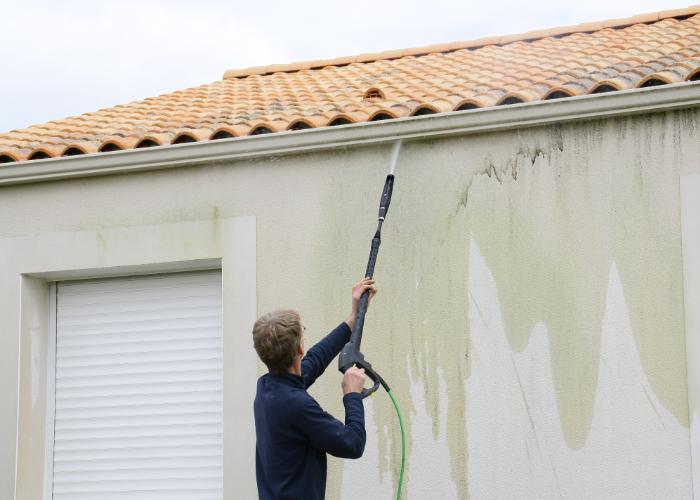
Stucco is a popular exterior finish known for its durability, textured appearance, and ability to add timeless charm to a home. But when it comes to cleaning it, especially with a pressure washer, many homeowners wonder:
Can pressure washing damage stucco over time?
The short answer: Yes — if done improperly.
Stucco can handle light washing, but it’s not invincible. In fact, using the wrong technique, pressure setting, or nozzle can lead to cracking, erosion, or even water intrusion. Let’s explore how to clean stucco safely and what to avoid if you want to preserve its look and structure. 🧼🏡
🧱 Understanding Stucco’s Unique Properties
Stucco is typically made from a mixture of:
- Cement
- Sand
- Lime
- Water
This creates a semi-porous finish that breathes, resists moisture to a degree, and adds insulation to your home. However, this porous nature also makes it more vulnerable to high-pressure water. Over time, poor washing practices can wear down its protective outer layer, or worse — allow water to seep in.
🚫 How Pressure Washing Can Damage Stucco
Here are the most common ways damage happens:
- Surface erosion: High PSI can blast away the top layer, exposing sand or creating a patchy appearance.
- Cracking: Older or already brittle stucco may crack when exposed to sudden force or water expansion inside the surface.
- Water intrusion: Improper washing angles can push water behind the stucco, leading to mold, rot, or wall swelling.
- Staining: Aggressive washing may disturb mineral deposits, causing dark streaks or blotchy patches.
These effects usually don’t show up right away. Instead, they build gradually with repeated pressure washing done without care. ⏳⚠️
✅ Best Practices for Pressure Washing Stucco Safely
Done right, pressure washing can clean stucco effectively without long-term damage. Here’s how to do it the safe way:
1. Use a Low-Pressure Setting
Keep your washer under 1,500 PSI. Stucco is softer than concrete, and blasting it with full force can easily do harm. Use a wide-angle nozzle — 25° or 40° is ideal. 💦
2. Choose the Right Nozzle
Stick with a fan tip and avoid turbo nozzles or anything too narrow (0° or 15°). A wider spray distributes water more evenly, reducing the risk of erosion.
Browse Amazon Here For Popular Pressure Washers And Accessories
3. Stand at a Distance
Maintain at least 2 feet of distance between the nozzle and the surface. If you need to get closer to clean stubborn areas, reduce the pressure further.
4. Spray at a Downward Angle
Always spray downward or from the side — never upward. This prevents water from being forced under cracks or into seams.
5. Pre-Wet and Soak in Sections
Start by lightly wetting the stucco to loosen surface dirt. Apply a mild detergent specifically for stucco or siding, let it sit for 5–10 minutes, then rinse gently.
🧴 What Kind of Cleaner Should You Use?
Avoid bleach or acidic cleaners. Instead, opt for:
- Oxygenated cleaners
- Eco-friendly mold/mildew removers
- Biodegradable detergents
These help break down grime without harming plants, pets, or the stucco surface. ♻️🌿
Browse Amazon Here For Biodegradable Pressure Washing Detergents
🛠️ What If You See Cracks?
If you notice cracks in your stucco before washing, do not pressure wash until those are repaired. Water forced into even hairline cracks can get behind the wall and cause:
- Swelling
- Interior water damage
- Mold or mildew growth
- Paint bubbling or peeling
Fixing these issues after the fact can cost thousands. 💸🧯
🧽 Alternatives to Pressure Washing Stucco
For older stucco, delicate areas, or very dirty patches, try:
- Soft washing: Uses low-pressure water + gentle cleaners
- Hand scrubbing with a sponge or brush and mild soap
- Hose with spray attachment for maintenance cleaning
- Vinegar and water for mild mold or mildew
These methods take a little more time, but they’re safer for fragile or aging finishes.
🏠 How Often Should You Clean Stucco?
A good rule of thumb is once a year, ideally in spring or fall. But if you live in a humid area or near lots of trees, you might need to clean twice per year to keep mold, dirt, and pollen in check.
✨ Final Takeaway
Pressure washing stucco can be safe — but only with the right approach. If you blast away carelessly, you risk doing serious damage that may not show until it’s too late. Here’s what to remember:
- Use low pressure and wide-angle nozzles
- Stay 2+ feet away
- Avoid cracks and upward spraying
- Use gentle cleaners
- Inspect your stucco before starting
If your stucco is in great shape and you use the right tools, pressure washing can restore its beauty without putting your home at risk. But when in doubt, go low and slow — or hire a professional. 🧼🏚️💦
Browse Amazon Here For Popular Pressure Washers And Accessories






